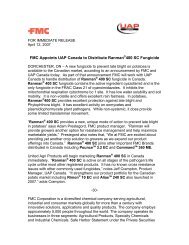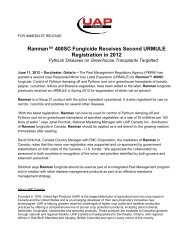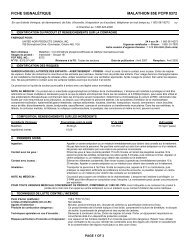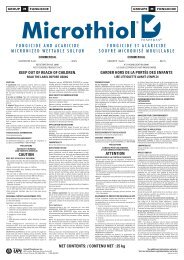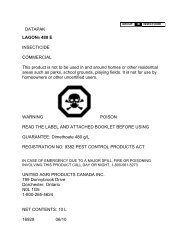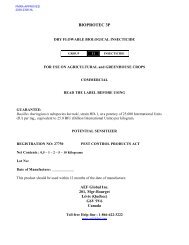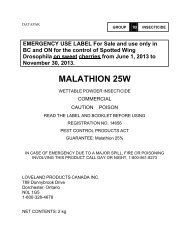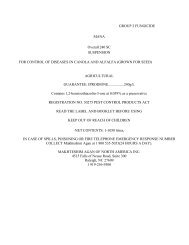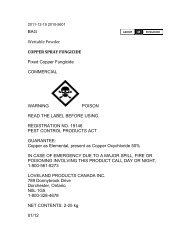MSDS - UAP
MSDS - UAP
MSDS - UAP
You also want an ePaper? Increase the reach of your titles
YUMPU automatically turns print PDFs into web optimized ePapers that Google loves.
MATERIAL SAFETY DATA SHEET<br />
COMMAND® 3 ME MICROENCAPSULATED HERBICIDE<br />
<strong>MSDS</strong> Ref. No.: 81777-89-1-6<br />
Date Approved: 11/30/2007<br />
Revision No.: 13<br />
This document has been prepared to meet the requirements of the U.S. OSHA Hazard Communication<br />
Standard, 29 CFR 1910.1200 and Canada’s Workplace Hazardous Materials Information System (WHMIS)<br />
requirements.<br />
1. PRODUCT AND COMPANY IDENTIFICATION<br />
PRODUCT NAME:<br />
PRODUCT CODE: 1693; 6270<br />
ACTIVE INGREDIENT(S):<br />
CHEMICAL FAMILY:<br />
MOLECULAR FORMULA:<br />
SYNONYMS:<br />
COMMAND® 3 ME MICROENCAPSULATED HERBICIDE<br />
Clomazone<br />
Herbicide<br />
(clomazone)<br />
FMC 57020; 2-(2-chlorophenyl)methyl-4,4-dimethyl-3-<br />
isoxazolidinone; IUPAC: 2-(2-chlorobenzyl)-4,4-dimethyl-1,2-<br />
oxazolidin-3-one; 2-(2-chlorobenzyl)-4,4-dimethylisoxazolidin-3-<br />
one<br />
ALTERNATE PRODUCT NAME(S): Command® 360 ME, Command® 36 CS, Command® 360 CS,<br />
Command® CS, Centium 36 CS, Cirrus 36 CS, Cirrus CS,<br />
Gamit® 36 CS, Gamit® 360 CS, Gamit® CS<br />
MANUFACTURER<br />
FMC CORPORATION<br />
Agricultural Products Group<br />
1735 Market Street<br />
Philadelphia, PA 19103<br />
(215) 299-6000 (General Information)<br />
msdsinfo@fmc.com (Email - General Information)<br />
EMERGENCY TELEPHONE NUMBERS<br />
(800) 331-3148 (Medical - U.S.A. & Canada)<br />
(651) 632-6793 (Medical - Collect - All Other Countries)<br />
For leak, fire, spill, or accident emergencies, call:<br />
(800) 424-9300 (CHEMTREC - U.S.A. & Canada)<br />
(703) 527-3887 (CHEMTREC - Collect - All Other Countries)<br />
2. HAZARDS IDENTIFICATION<br />
EMERGENCY OVERVIEW:<br />
• Brown liquid with a slightly aromatic hydrocarbon odor.<br />
• Slightly combustible. May support combustion at elevated temperatures.<br />
• Thermal decomposition and burning may form toxic by-products.<br />
• For large exposures or fire, wear personal protective equipment.<br />
Page 1 of 10
COMMAND® 3 ME MICROENCAPSULATED HERBICIDE (81777-89-1-6) Date: 11/30/2007<br />
• Highly to slightly toxic to fish and aquatic organisms. Keep out of drains and watercourses.<br />
POTENTIAL HEALTH EFFECTS: Effects from overexposure result from coming into<br />
contact with the skin and eyes. Symptoms of overexposure include nasal discharge.<br />
MEDICAL CONDITIONS AGGRAVATED: None presently known.<br />
3. COMPOSITION / INFORMATION ON INGREDIENTS<br />
Chemical Name CAS# Wt.% EC No. EC Class<br />
Clomazone 81777-89-1 31.4 None R20/22-R52; S2-46-29<br />
Polymeric Isocyanates 9016-87-9 1 - 5 None Not classified<br />
Calcium Chloride 10043-52-4 1 - 5 233-140-8 R36; S2-22-24<br />
4. FIRST AID MEASURES<br />
EYES: Flush with plenty of water. Get medical attention if irritation occurs and persists.<br />
SKIN: Wash with plenty of soap and water.<br />
INGESTION: Rinse mouth with water. Dilute by giving 1 or 2 glasses of water. Do not induce<br />
vomiting. Never give anything by mouth to an unconscious person. See a medical doctor immediately.<br />
INHALATION: Remove to fresh air. If breathing difficulty or discomfort occurs and persists,<br />
contact a medical doctor.<br />
NOTES TO MEDICAL DOCTOR: This product has low oral, dermal and inhalation<br />
toxicity. It is non-irritating to the eyes and skin. Treatment is otherwise controlled removal of exposure<br />
followed by symptomatic and supportive care.<br />
5. FIRE FIGHTING MEASURES<br />
EXTINGUISHING MEDIA: Foam, CO 2 or dry chemical. Soft stream water fog only if<br />
necessary. Contain all runoff.<br />
Page 2 of 10
COMMAND® 3 ME MICROENCAPSULATED HERBICIDE (81777-89-1-6) Date: 11/30/2007<br />
FIRE / EXPLOSION HAZARDS: Slightly combustible. This material may support<br />
combustion at elevated temperatures.<br />
FIRE FIGHTING PROCEDURES: Isolate fire area. Evacuate downwind. Wear full<br />
protective clothing and self-contained breathing apparatus. Do not breathe smoke, gases or vapors<br />
generated.<br />
FLAMMABLE LIMITS: Not available<br />
6. ACCIDENTAL RELEASE MEASURES<br />
RELEASE NOTES: Isolate and post spill area. Wear protective clothing and personal protective<br />
equipment as prescribed in Section 8, "Exposure Controls/Personal Protection". Keep unprotected persons<br />
and animals out of the area.<br />
Keep material out of lakes, streams, ponds and sewer drains. Dike to confine spill and absorb with a noncombustible<br />
absorbent such as clay, sand or soil. Vacuum, shovel or pump waste into a drum and label<br />
contents for disposal.<br />
To clean and neutralize tools and equipment, wash with a 20% solution of potassium hydroxide in<br />
methanol. Follow by washing with strong soap and rinsing with water, and add both solutions to the drums<br />
of waste already collected.<br />
To clean and neutralize spill areas, spray the area with a 20% solution of potassium hydroxide in methanol.<br />
Cover the treated area with plastic and let stand for 24 hours. Remove the covering and place in a drum for<br />
later disposal. Wash the area, three times, with a strong soap and rinse with water. If spill occurs on a<br />
wooden surface, repeat the entire process again. Absorb, as above, any excess liquid and add to the drums<br />
of waste already collected. Dispose of drummed waste according to the method outlined in Section 13,<br />
"Disposal Considerations".<br />
7. HANDLING AND STORAGE<br />
HANDLING AND STORAGE: Store in a cool, dry, well-ventilated place. Do not use or<br />
store near heat, open flame or hot surfaces. Store in original containers only. STORE ABOVE -4°F (-20°C)<br />
TO KEEP PRODUCT FROM FREEZING. If frozen, thaw before reuse. For re-circulation directions, refer<br />
to the product label under ''Mixing and Handling'' instructions, for ''Bulk/Mini-Bulk Containers''. Keep out<br />
of reach of children and animals. Do not contaminate other pesticides, fertilizers, water, food or feed by<br />
storage or disposal.<br />
Page 3 of 10
COMMAND® 3 ME MICROENCAPSULATED HERBICIDE (81777-89-1-6) Date: 11/30/2007<br />
8. EXPOSURE CONTROLS / PERSONAL PROTECTION<br />
EXPOSURE LIMITS<br />
Chemical Name ACGIH OSHA Supplier<br />
Calcium Chloride 10 mg/m 3<br />
ENGINEERING CONTROLS: Use local exhaust at all process locations where vapor or<br />
mist may be emitted. Ventilate all transport vehicles prior to unloading.<br />
PERSONAL PROTECTIVE EQUIPMENT<br />
EYES AND FACE: For splash, mist or spray exposure, wear chemical protective goggles<br />
or a face shield.<br />
RESPIRATORY: For splash, mist or spray exposures wear, as a minimum, a properly<br />
fitted half-face or full-face air-purifying respirator which is approved for pesticides (U.S.<br />
NIOSH/MSHA, EU CEN or comparable certification organization). Respirator use and selection<br />
must be based on airborne concentrations.<br />
PROTECTIVE CLOTHING: Depending upon concentrations encountered, wear<br />
coveralls or long-sleeved uniform and head covering. For larger exposures as in the case of spills,<br />
wear full body cover barrier suit, such as a PVC suit. Leather items - such as shoes, belts and<br />
watchbands - that become contaminated should be removed and destroyed. Launder all work<br />
clothing before reuse (separately from household laundry).<br />
GLOVES: Wear chemical protective gloves made of materials such as nitrile or Viton®<br />
brand. Thoroughly wash the outside of gloves with soap and water prior to removal. Inspect<br />
regularly for leaks.<br />
WORK HYGIENIC PRACTICES: Clean water should be available for washing in case of<br />
eye or skin contamination. Wash skin prior to eating, drinking, chewing gum, or using tobacco. Shower at<br />
the end of the workday.<br />
COMMENTS:<br />
CANADIAN OCCUPATIONAL EXPOSURE LIMITS (OELs)<br />
Polymeric isocyanate<br />
Alberta: 0.005 ppm; 0.07 mg/m³ (TWA)<br />
Calcium chloride<br />
Ontario: 5 mg/m³ (TWAEV)<br />
Page 4 of 10
COMMAND® 3 ME MICROENCAPSULATED HERBICIDE (81777-89-1-6) Date: 11/30/2007<br />
9. PHYSICAL AND CHEMICAL PROPERTIES<br />
ODOR:<br />
Slight aromatic<br />
APPEARANCE:<br />
Brown liquid<br />
AUTOIGNITION TEMPERATURE: Not available<br />
BOILING POINT:<br />
Not available<br />
COEFFICIENT OF OIL / WATER: Not available<br />
DENSITY / WEIGHT PER VOLUME: Not available<br />
EVAPORATION RATE:<br />
Not available<br />
FLASH POINT:<br />
> 94 °C (> 201 °F) (TOC)<br />
FREEZING POINT:<br />
Not available<br />
MOLECULAR WEIGHT:<br />
239.7 (clomazone)<br />
ODOR THRESHOLD:<br />
Not available<br />
pH: 6.5 @ 20°C<br />
SOLUBILITY IN WATER:<br />
Disperses<br />
SPECIFIC GRAVITY:<br />
Not available<br />
VAPOR PRESSURE:<br />
Not available<br />
10. STABILITY AND REACTIVITY<br />
CONDITIONS TO AVOID:<br />
STABILITY:<br />
POLYMERIZATION:<br />
HAZARDOUS DECOMPOSITION PRODUCTS:<br />
Excessive heat and fire.<br />
Stable<br />
Will not occur<br />
Carbon monoxide and/or carbon dioxide, oxides of<br />
nitrogen, chlorine and hydrogen chloride.<br />
11. TOXICOLOGICAL INFORMATION<br />
EYE EFFECTS: Non-irritating<br />
SKIN EFFECTS: Non-irritating<br />
DERMAL LD 50 : > 5,000 mg/kg (rat)<br />
ORAL LD 50 : > 5,000 mg/kg (rat)<br />
Page 5 of 10
COMMAND® 3 ME MICROENCAPSULATED HERBICIDE (81777-89-1-6) Date: 11/30/2007<br />
INHALATION LC 50 : > 5.21 mg/l (4 h) (rat) Maximum attainable concentration - zero mortality<br />
ACUTE EFFECTS FROM OVEREXPOSURE: This product has low oral, dermal<br />
and inhalation toxicity. It is non-irritating to the eyes and skin. Signs of toxicity noted in laboratory animals<br />
included abdominogenital staining, chromorhinorrhea, chromodacryorrhea, decreased locomotion, dyspnea,<br />
diarrhea, and oral and nasal discharge. Calcium chloride may cause moderate to severe eye irritation, which<br />
may result in corneal injury. Prolonged or repeated exposure of calcium chloride, on the skin, may cause<br />
skin irritation or even burns; the severity of skin irritation may increase on damp or abraded skin.<br />
CHRONIC EFFECTS FROM OVEREXPOSURE: No data available for the<br />
formulation. In studies with laboratory animals, clomazone did not cause reproductive toxicity,<br />
teratogenicity, or carcinogenicity. Liver enlargement and elevated cholesterol levels are often noted in<br />
laboratory animals that have ingested large doses of clomazone during their lifespan. An overall absence of<br />
genotoxicity has been demonstrated in tests of mutagenicity, DNA damage and chromosome aberrations.<br />
CARCINOGENICITY:<br />
NTP:<br />
IARC:<br />
OSHA:<br />
OTHER:<br />
Not listed<br />
Not listed<br />
Not listed<br />
(ACGIH) Not listed<br />
12. ECOLOGICAL INFORMATION<br />
ENVIRONMENTAL DATA: Clomazone has a moderate rate of degradation in soil (half-life<br />
= 24 days), and is stable to hydrolysis over a wide range of pH. The bioconcentration potential for<br />
clomazone is low, with a Log Pow of 2.5, and a measured bioconcentration factor (BCF) of 27 - 40. Field<br />
studies showed that clomazone does not significantly leach below 15 cm in soil and is, therefore, not<br />
expected to enter groundwater.<br />
ECOTOXICOLOGICAL INFORMATION: Command 3 ME:<br />
Freshwater fish: 96-hour LC 50 = 592.7 (Rainbow trout) (low toxicity)<br />
Freshwater invertebrates: 48-hour EC 50 = 491.3 mg/L (Daphnia) (low toxicity)<br />
Freshwater aquatic plants: EC 50 = 681.47 mg/L (Duckweed) (low toxicity)<br />
Algae, 96-hour EbC50 = 160.85 mg/L (low toxicity)<br />
Clomazone Technical:<br />
Freshwater fish: 96-hour LC 50 = 34 mg/L (Bluegill sunfish) (slightly toxic)<br />
Estuarine invertebrates: 96-hour LC 50 = 8.9 mg/L (Pink shrimp) (moderately toxic)<br />
Estuarine fish: LC 50 = 6.3 (Atlantic silverside, moderately toxic)<br />
Estuarine fish: LC 50 = 41 mg/L (Sheepshead minnow, slightly toxic)<br />
Estuarine invertebrate: LC 50 = 0.57 mg/L (Mysid) (highly toxic)<br />
Waterfowl / Upland game birds: Oral LD 50 >2510 mg/kg; Dietary LC 50 >5620 ppm (low toxicity)<br />
Care should be taken to avoid contamination of the aquatic environment.<br />
Page 6 of 10
COMMAND® 3 ME MICROENCAPSULATED HERBICIDE (81777-89-1-6) Date: 11/30/2007<br />
13. DISPOSAL CONSIDERATIONS<br />
DISPOSAL METHOD: Open dumping or burning of this material or its packaging is prohibited.<br />
If spilled material cannot be disposed of by use according to label instructions, an acceptable method of<br />
disposal is to incinerate in accordance with local, state and national environmental laws, rules, standards<br />
and regulations. However, because acceptable methods of disposal may vary by location and regulatory<br />
requirements may change, the appropriate agencies should be contacted prior to disposal.<br />
EMPTY CONTAINER: Non-returnable containers that held this material should be cleaned,<br />
prior to disposal, by triple rinsing. Containers which held this material may be cleaned by being triplerinsed,<br />
and recycled, with the rinsate being incinerated. Do not cut or weld metal containers. Vapors that<br />
form may create an explosion hazard.<br />
14. TRANSPORT INFORMATION<br />
U.S. DEPARTMENT OF TRANSPORTATION (DOT)<br />
PACKAGING TYPE:<br />
ADDITIONAL INFORMATION:<br />
Non-Bulk<br />
This material is not a hazardous material as<br />
defined by US Department of<br />
Transportation at 49 CFR Parts 100 through<br />
185.<br />
PACKAGING TYPE:<br />
ADDITIONAL INFORMATION:<br />
Bulk<br />
This material is not a hazardous material as<br />
defined by US Department of<br />
Transportation at 49 CFR Parts 100 through<br />
185.<br />
INTERNATIONAL MARITIME DANGEROUS GOODS (IMDG)<br />
PACKAGING TYPE:<br />
ADDITIONAL INFORMATION:<br />
Non-Bulk<br />
This material is not a dangerous good as<br />
defined by the International Maritime<br />
Dangerous Goods Code.<br />
ADR - EUROPEAN AGREEMENT CONCERNING THE<br />
INTERNATIONAL CARRIAGE OF DANGEROUS GOODS BY ROAD<br />
Page 7 of 10
COMMAND® 3 ME MICROENCAPSULATED HERBICIDE (81777-89-1-6) Date: 11/30/2007<br />
PACKAGING TYPE:<br />
ADDITIONAL INFORMATION:<br />
Non-Bulk<br />
This material is not a dangerous good as<br />
defined by ADR.<br />
INTERNATIONAL CIVIL AVIATION ORGANIZATION (ICAO) /<br />
INTERNATIONAL AIR TRANSPORT ASSOCIATION (IATA)<br />
PACKAGING TYPE:<br />
ADDITIONAL INFORMATION:<br />
Non-Bulk<br />
This material is not a dangerous good as<br />
defined in ICAO and the International Air<br />
Transport Association (IATA) Dangerous<br />
Goods Regulations.<br />
OTHER INFORMATION:<br />
CANADIAN TRANSPORT (TDG):<br />
PACKAGING TYPE: Bulk & Non-bulk<br />
ADDITIONAL INFORMATION: This material is not a dangerous good as defined by TDG Regulations.<br />
HARMONIZED SYSTEM<br />
Import to the U.S.A.: 3808.93.1500<br />
Export from the U.S.A.: 3808.93.0000<br />
15. REGULATORY INFORMATION<br />
UNITED STATES<br />
SARA TITLE III (SUPERFUND AMENDMENTS AND REAUTHORIZATION ACT)<br />
SECTION 302 EXTREMELY HAZARDOUS SUBSTANCES (40 CFR 355, APPENDIX A):<br />
Not listed<br />
SECTION 311 HAZARD CATEGORIES (40 CFR 370):<br />
Immediate, Delayed<br />
SECTION 312 THRESHOLD PLANNING QUANTITY (40 CFR 370):<br />
The Threshold Planning Quantity (TPQ) for this product, if treated as a mixture, is 10,000 lbs;<br />
however, this product contains the following ingredients with a TPQ of less than 10,000 lbs.:<br />
None<br />
SECTION 313 REPORTABLE INGREDIENTS (40 CFR 372):<br />
This product contains the following ingredients subject to Section 313 reporting requirements:<br />
Polymeric isocyanate<br />
Page 8 of 10
COMMAND® 3 ME MICROENCAPSULATED HERBICIDE (81777-89-1-6) Date: 11/30/2007<br />
CERCLA (COMPREHENSIVE ENVIRONMENTAL RESPONSE COMPENSATION AND<br />
LIABILITY ACT)<br />
CERCLA DESIGNATION & REPORTABLE QUANTITIES (RQ) (40 CFR 302.4):<br />
Not listed<br />
FEDERAL INSECTICIDE FUNGICIDE RODENTICIDE ACT<br />
U.S. EPA Signal Word: CAUTION<br />
CANADA<br />
WHMIS (WORKPLACE HAZARDOUS MATERIALS INFORMATION SYSTEM):<br />
This product has been classified in accordance with the hazard criteria of the Controlled Products<br />
Regulations and the <strong>MSDS</strong> contains all the information required by the Controlled Products<br />
Regulations.<br />
Hazard Classification / Division: D2A<br />
D2B<br />
INTERNATIONAL LISTINGS<br />
CANADIAN NATIONAL POLLUTANT RELEASE INVENTORY (NPRI):<br />
Polymeric isocyanate: Part 1, Group 1 Substance<br />
Australian Hazard Code: Not available<br />
HAZARD, RISK AND SAFETY PHRASE DESCRIPTIONS:<br />
Clomazone:<br />
EC Symbols: Xn (Harmful)<br />
EC Risk Phrases:<br />
R20/22 (Harmful by inhalation and if swallowed.)<br />
R52 (Harmful to aquatic organisms.)<br />
EC Safety Phrases: S2 (Keep out of the reach of children.)<br />
S46 (If swallowed, seek medical advice immediately and show this<br />
container or label.)<br />
S29 (Do not empty into drains.)<br />
Calcium chloride, (Index #017-013-00-2):<br />
EC Symbols: Xi (Irritant)<br />
Page 9 of 10
COMMAND® 3 ME MICROENCAPSULATED HERBICIDE (81777-89-1-6) Date: 11/30/2007<br />
EC Risk Phrases: R36 (Irritating to eyes.)<br />
EC Safety Phrases: S2 (Keep out of the reach of children.)<br />
S22 (Do not breathe dust.)<br />
S24 (Avoid contact with skin.)<br />
16. OTHER INFORMATION<br />
REVISION SUMMARY:<br />
This <strong>MSDS</strong> replaces Revision #12, dated May 29, 2007.<br />
Changes in information are as follows:<br />
Section 1 (Product and Company Identification)<br />
Section 3 (Composition / Information on Ingredients)<br />
Section 14 (Transport Information)<br />
Section 15 (Regulatory Information)<br />
Section 16 (Other Information)<br />
Command, Centium, Cirrus, Gamit and FMC - FMC Trademarks<br />
Viton - E.I. du Pont de Nemours & Co. Trademark<br />
© 2007 FMC Corporation. All Rights Reserved.<br />
FMC Corporation believes that the information and recommendations contained herein (including data and<br />
statements) are accurate as of the date hereof. NO WARRANTY OF FITNESS FOR ANY PARTICULAR<br />
PURPOSE, WARRANTY OF MERCHANTABILITY, OR ANY OTHER WARRANTY, EXPRESSED<br />
OR IMPLIED, IS MADE CONCERNING THE INFORMATION PROVIDED HEREIN. The information<br />
provided herein relates only to the specific product designated and may not be applicable where such<br />
product is used in combination with any other materials or in any process. Use of this product is regulated<br />
by the U.S. Environmental Protection Agency (EPA). It is a violation of Federal law to use this product in a<br />
manner inconsistent with its labeling. Further, since the conditions and methods of use are beyond the<br />
control of FMC Corporation, FMC Corporation expressly disclaims any and all liability as to any results<br />
obtained or arising from any use of the product or reliance on such information.<br />
Page 10 of 10



